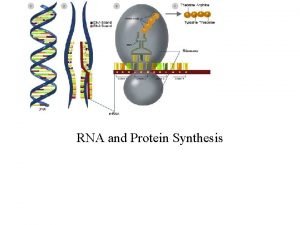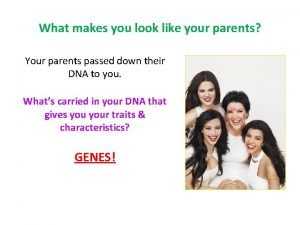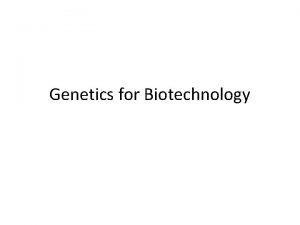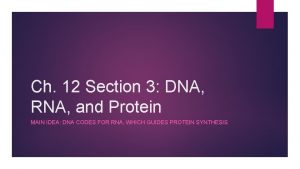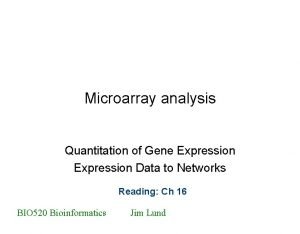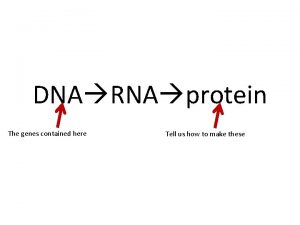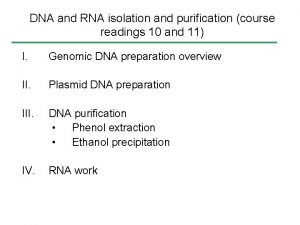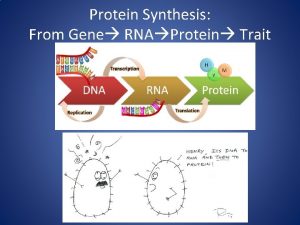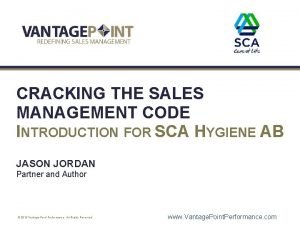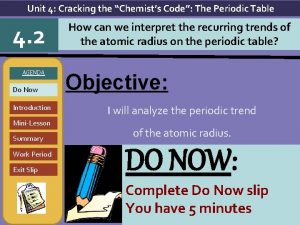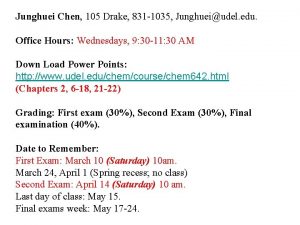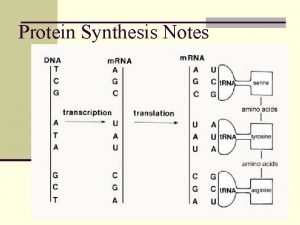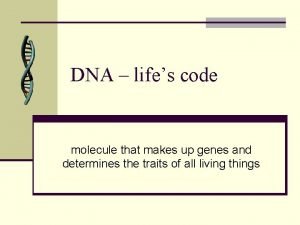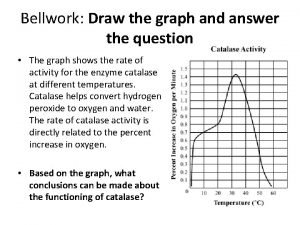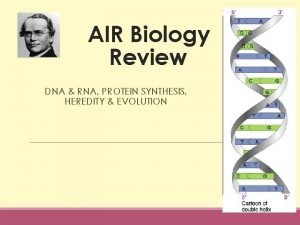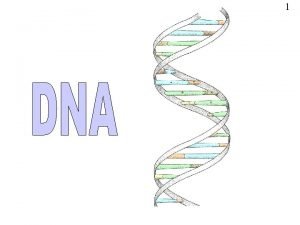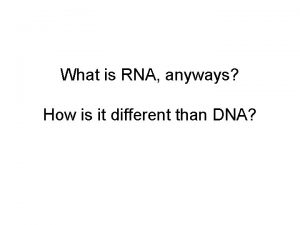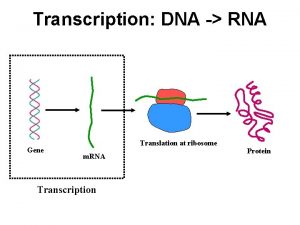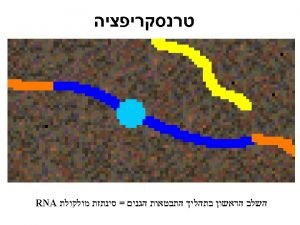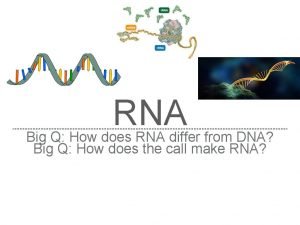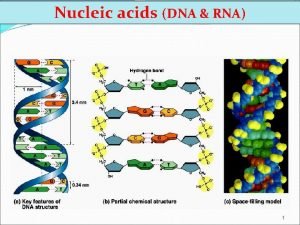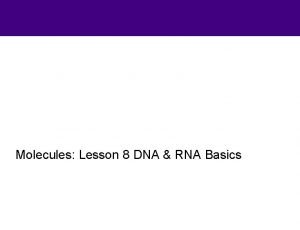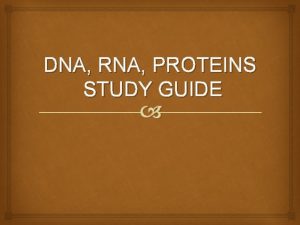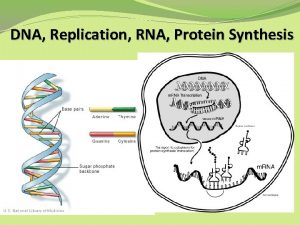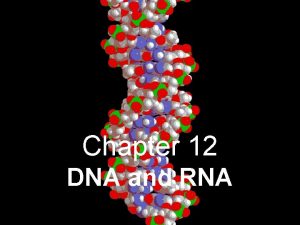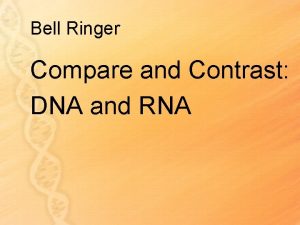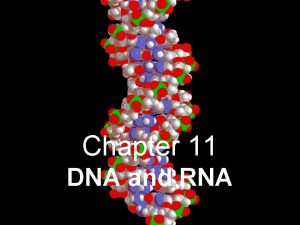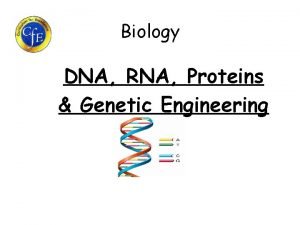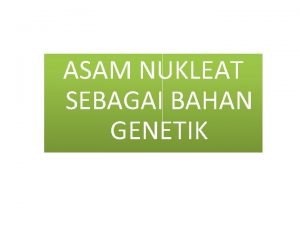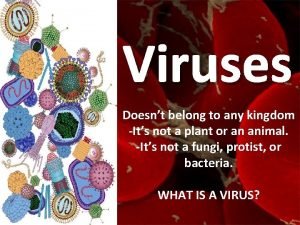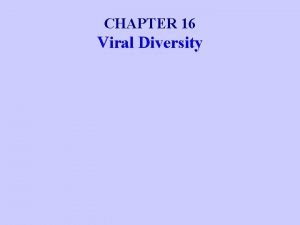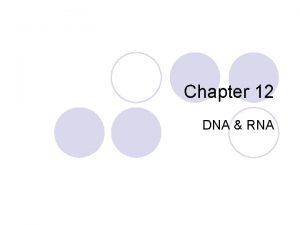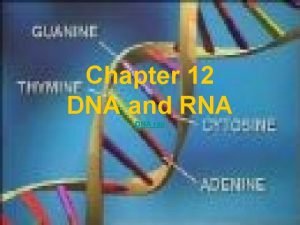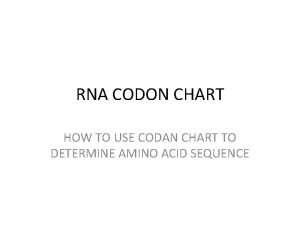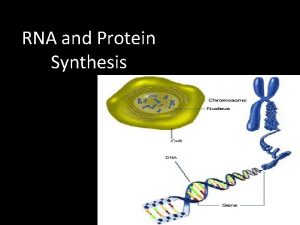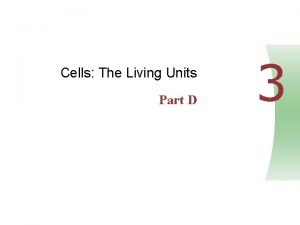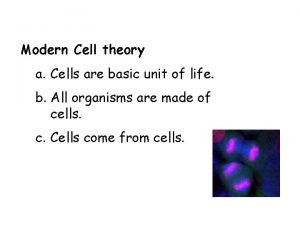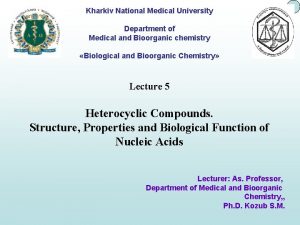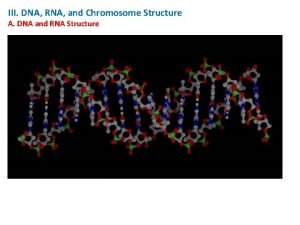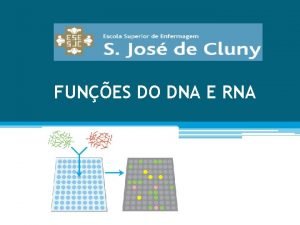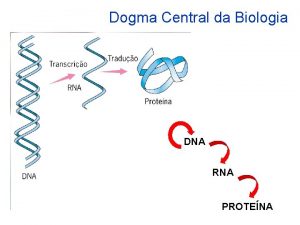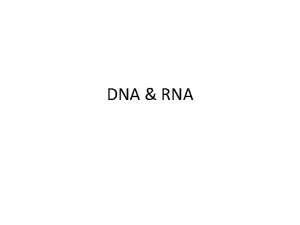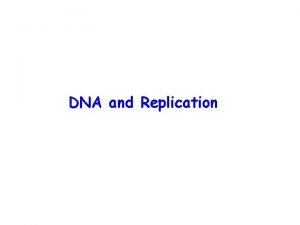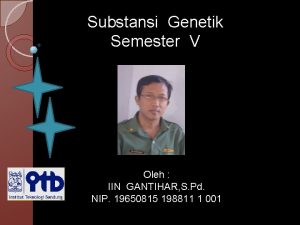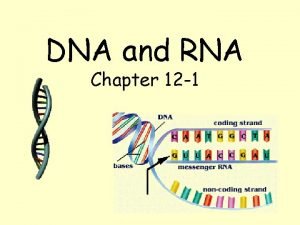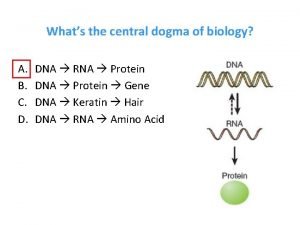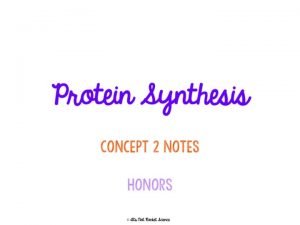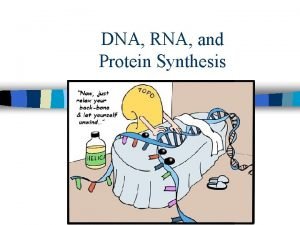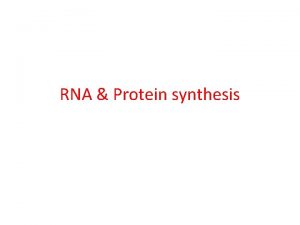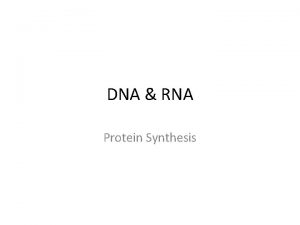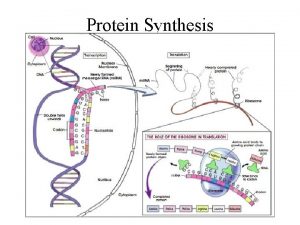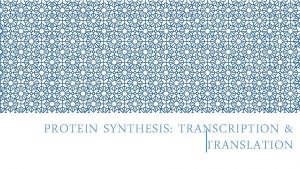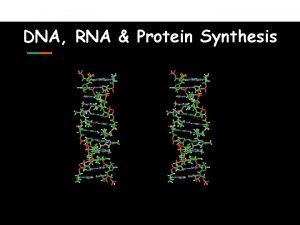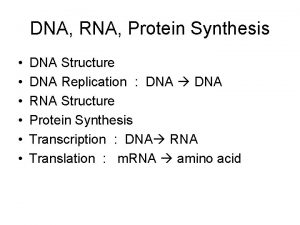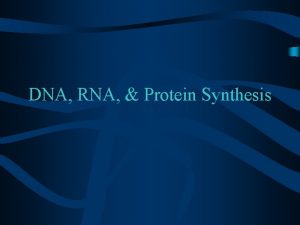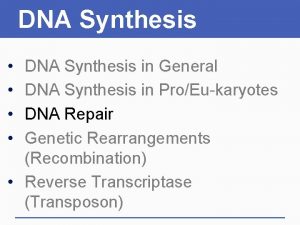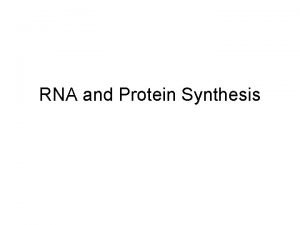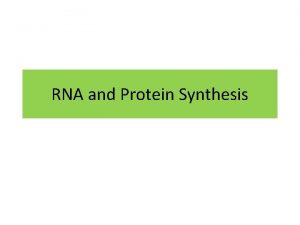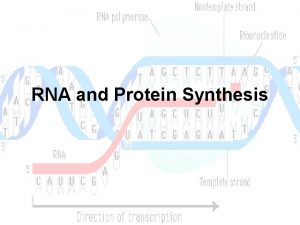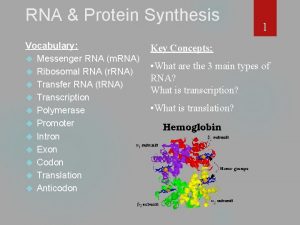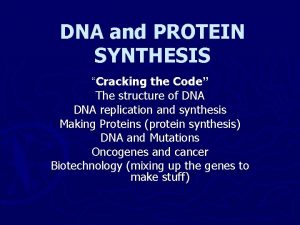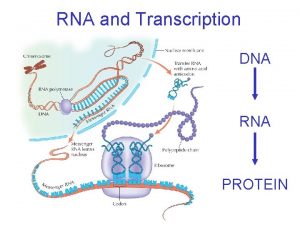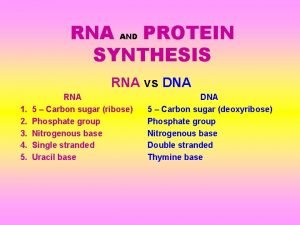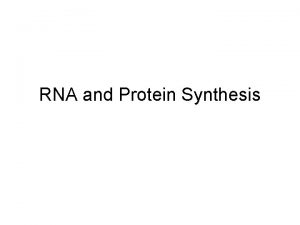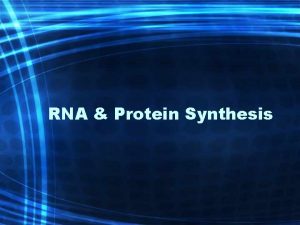DNA RNA Protein Synthesis Cracking the Code of



































































- Slides: 67

DNA, RNA & Protein Synthesis Cracking the Code of Life clip: Click on “Watch The Program” and view the first 9 minutes http: //www. pbs. org/wgbh/nova/body/cracking-the-code-of-life. html

Genetic code: The way cells translate information in DNA into proteins o Genetics refers to anything that relates to heredity

The Structure of DNA • DNA = Deoxyribo. Nucleic Acid = A polymer formed from units called nucleotides • Each nucleotide is composed of 3 parts: 1. 5 -carbon sugar (deoxyribose) 2. Phosphate group 3. nitrogenous base

The Structure of DNA: Nitrogenous Bases o The purines: double rings 1. Adenine 2. Guanine o The pyrimadines single rings 1. Cytosine 2. Thymine 3. Uracil (RNA)

Do You Notice a Pattern? Relative Proportions of Nitrogenous Bases in DNA (%) Organism A T G C Human 30. 9 29. 4 19. 9 19. 8 Chicken 28. 8 28. 2 20. 5 21. 5 Grasshopper 29. 3 20. 5 20. 7 Sea Urchin 32. 8 32. 1 17. 7 17. 3 Wheat 27. 3 27. 1 22. 7 22. 8 Yeast 31. 3 32. 9 18. 7 17. 1 E. coli 24. 7 23. 6 26. 0 25. 7

Base Pairing: AKA Chargaff ‘s Rule • Adenine hydrogen bonds to Thymine • Cytosine hydrogen bonds to Guanine

Hydrogen Bonds = the force that holds DNA’s two separate strands together.

1953 -Watson&Crick: • Developed a model of DNA’s structure • Double Helix = two strands twisted

DNA structure video: (1: 19) http: //www. youtube. com/watch? v=qy 8 d k 5 i. S 1 f 0

DNA REPLICATION: Before a cell divides, it must duplicate its DNA. • Copying DNA = Replication • Carried out by enzymes

The steps of replication: 1. DNA unzips: hydrogen bonds are broken and the two strands unwind (Helicase). 2. Each strand serves as a template. 3. The complementary bases attach by DNA polymerase. 4. DNA Ligase links pieces into a single strand 5. Each strand is “proof-read”

DNA replication video (0: 48) http: //youtube. com/watch? v=hf. Z 8 o 9 D 1 tus

Original strand Enzymes unzip strand A T G G C T Complimentary A - T T -A bases are G -C attached C -G T -A A-T T-A G-C C-G T-A T A C C G A A-T T- A G -C C -G T- A Two new strands are identical to each other and the original.

DNA wrapping & DNA Replication 3: 06

Q: How is the information contained in DNA used? A: DNA stays in the ____. nucleus RNA The sequence must be copied into ____. The RNA (_______) acts as a ribonucleic acid ribosomes messenger between DNA and ____.


The Structure of RNA: a single-stranded polymer formed from nucleotides 1. 5 -Carbon sugar (_____) ribose 2. _______ Phosphate group 3. Nitrogen base • cytosine • guanine • adenine uracil • _____

Transcription: process by which a portion of DNA is copied into a complementary strand of RNA. http: //www. stolaf. edu/people/giannini/flashanimat/molgenetics/transcription. swf RNA polymerase 1. An enzyme, _______, attaches to “start signal” (promoter). DNA at a __________ The DNA is separated into 2 strands. 2. _______________ synthesized 3. RNA is _____. The RNA strand is _______ to the DNA strand. complementary

4. RNA is released at a________ “stop signal” (terminator). m. RNA is processed 5. __________

m. RNA Splicing Non-coding • ______segments (introns) are removed. Coding • _______ segments (exons) are spliced together.

A AA U G G C U U A U U U GC AAUGGCUUAUUUGCA

• DNA Transcription 1: 52

3 Main Types of RNA 1. m. RNA (messenger RNA): brings the message of DNA out of the nucleus and to the ribosomes

2. t. RNA (transfer RNA) Carries amino acids from the cytoplasm to the ribosomes where polypeptides (proteins) are formed

• anticodon- 3 nucleotides that are complementary to 3 nucleotides of m. RNA

3. r. RNA (ribosomal RNA): makes up the ribosome • consists of a small subunit & a large subunit

COMPARING THE STRUCTURE OF DNA AND RNA: DNA Name Deoxyribo. Nucleic Acid RNA Ribo. Nucleic Acid Strand # Double Strand (ds) Sugar Deoxyribose Bases Cytosine, Guanine, Adenine, Thymine Types One Single Strand (ss) Ribose Cytosine, Guanine, Adenine, Uracil 3 = m. RNA, r. RNA, t. RNA

DNA codes for proteins • Proteins control biochemical pathways in cells

• Proteins are made of amino acids together forming long chains called polypeptides.

• Each combination of 3 nucleotides on m. RNA form a codon. • Each codon is for a specific amino acid. • There are 64 different codons which code for 20 amino acids.


Protein Synthesis Translation: the synthesis of polypeptides (proteins) using information from m. RNA. http: //www. youtube. c om/watch? v=_EK 3 g 6 px 7 Ik (3: 30)

• Before translation can occur, the DNA sequence is transcribed into m. RNA in the nucleus.

• Then m. RNA leaves the nucleus and travels to r. RNA – the ribosome.

The Steps of Translation 1. An initiation code (AUG) signals the beginning. 2. t. RNA brings amino acids from the cytoplasm to the ribosome.

i. t. RNA adds the amino acid to the polypeptide chain as the m. RNA moves through the ribosome one codon at a time. ii. The t. RNA anticodon is complementary to the m. RNA codon.

3. At a stop codon, the polypeptide is released. Protein Synthesis 0: 21

Given the following DNA strand, transcribe and translate it into a polypeptide. Use the table at the bottom of the page to determine the corresponding amino acids. DNA: T–A–C–T–T–C–C–C–G–A–A–A–G–G–T–A–T–T m. RNA: t. RNA: (Anticodons) Amino Acids: (m. RNA chart)

Given the following DNA strand, transcribe and translate it into a polypeptide. Use the table at the bottom of the page to determine the corresponding amino acids. DNA: T–A–C–T–T–C–C–C–G–A–A–A–G–G–T–A–T–T m. RNA: A–U–G–A–A-G–G–G–C–U–U–U–C–C–A–U–A–A t. RNA: (Anticodons) U – A – C U – C C–C–G A–A–A Amino Acids: (m. RNA chart) Met – Lys – Gly – Phe – Pro – Stop G–G–U A–U–U

DNA & RNA Animations • Translation 2: 16 • Translation & Protein Assembly 3: 02 • Crash Course DNA Replication (12: 58) • Crash Course DNA Transcription & Translation (14: 07) • DNA Translation 3: 03 • DNA Stated Clearly 5: 24

What happens when there is an error in the human genome? mutation How do gene mutations affect a person? A gene mutation can prevent the normal protein from being made Mutation 1: 07

Gene Mutations: chemical changes in DNA affecting one gene; may be beneficial, neutral or harmful. Point mutations: affects a single nucleotide 1. Base substitution replacement of one nucleotide with another; may result in coding for a different amino acid.

Gene Mutations: chemical changes in DNA affecting one gene; may be beneficial, neutral or harmful. Point mutations: affects a single nucleotide 2. Frameshift mutation– nucleotide reading frame is altered; codes for different amino acid sequence after the point of the mutation. • Base insertion – a nucleotide is inserted • Base deletion – a nucleotide is deleted

If the mutation changes the amino acid sequence of the protein, the protein is likely to be nonfunctional and a new phenotype will result. Ex: various forms of albinism TYR gene mutation causes type 1 OCA 2 gene TYRP 1 gene SLC 45 A 2 gene mutation causes type 2 type 3 type 4

Chromosomal mutations: involve _______ segments of chromosomes, _____ chromosomes, whole entire sets and even _____ of chromosomes.

1. Chromosomal Mutations deletion loss of part of chromosomes duplication segment of chromosome is repeated inversion Part of chromosome becomes oriented in reverse of usual direction translocation Part of 1 chromosome breaks off & attaches to another non-homologous chromosome

Mutagenesis: creation of a mutation Mutagens (physical or chemical agents causing mutations) include radiation, high temperatures, chemical pollutants, & viruses.

Epigenetics video 13: 25

DNA TECHNOLOGIES Gel electrophoresis: Separation of pieces of DNA which have been cut by restriction enzymes according to fragment size.

Steps of gel electrophoresis: 1. Restriction enzymes cut DNA sample

2. The cut segments of DNA are loaded into the wells.

3. Negatively charged DNA fragments move toward “+” end of gel 4. Smaller pieces move faster and a further distance down the gel

Uses of Gel Electrophoresis • To compare different samples of DNA for identification or paternity • To locate a particular gene out of the thousands that an individual has • To determine an organism’s DNA sequence

Technologies using gel electrophoresis: 1. DNA fingerprinting • Identifying individuals: Which suspect was at the crime scene? Suspect #2

Technologies using gel electrophoresis: 1. DNA fingerprinting • Paternity Testing: Whose the father?

Technologies using gel electrophoresis: 1. DNA fingerprinting • Paternity Testing: Whose the father?

What is going on here?

Daughter 2 has a different father & Son 2 is adopted.

Technologies using gel electrophoresis: 1. DNA fingerprinting • Comparison of different organisms: How closely related are these species to the common ancestor?

DNA Fingerprinting Pod. Cast: 6 min Want to know more? Click here to run through a demo of DNA Fringerprinting

Technologies using gel electrophoresis: 2. Determine DNA sequence DNA screening: Using 4 samples of a single stranded DNA sequence and adding modified nitrogen bases, then running a gel electrophoresis


Lets determine the order of sequence of DNA! And the sequence is…… CCGAGGTCAG

Sequencing anyone? GCCATGTCCATGGCA ATCCGTCAGCA

Advantages to knowing a DNA sequence • Study specific genes • Compare genes from different organisms • Discover functions of different genes

NOVA - Cracking the Code of Life 1: 53: 00 Nova - Cracking Your Genetic Code - 53: 27

Gel Electrophoresis Animation Electrophoresis demo
 Dna and genes chapter 11
Dna and genes chapter 11 Dna protein synthesis study guide answers
Dna protein synthesis study guide answers Totipotent cells
Totipotent cells Section 12 3 rna and protein synthesis answers
Section 12 3 rna and protein synthesis answers Messenger rna codons
Messenger rna codons Rna transfer
Rna transfer Que es
Que es Mutations quiz
Mutations quiz Chapter 12 section 3 dna rna and protein
Chapter 12 section 3 dna rna and protein Microarray analysis
Microarray analysis Dna rna protein
Dna rna protein Dna rna protein diagram
Dna rna protein diagram Dna rna protein trait
Dna rna protein trait Cracking the sales management code pdf download
Cracking the sales management code pdf download Unit 4
Unit 4 Corliss jackson
Corliss jackson Synthesis of rna
Synthesis of rna Unlike dna, rna contains
Unlike dna, rna contains Dna vs rna worksheet answer key
Dna vs rna worksheet answer key Translation and transcription venn diagram
Translation and transcription venn diagram Dna and rna concept map
Dna and rna concept map Dna to rna rules
Dna to rna rules Transcription and translation venn diagram
Transcription and translation venn diagram Dna double helix coloring worksheet answer key
Dna double helix coloring worksheet answer key Dna number of strands
Dna number of strands Dna vs rna
Dna vs rna Protein synthesis
Protein synthesis Ribosomem
Ribosomem Rna or dna
Rna or dna How does rna differ from dna? *
How does rna differ from dna? * Nucleic acid
Nucleic acid Rnabases
Rnabases Dna rna and proteins study guide answers
Dna rna and proteins study guide answers Fraction
Fraction Dna and rna
Dna and rna Chapter 12 dna and rna
Chapter 12 dna and rna Compare and contrast dna and rna.
Compare and contrast dna and rna. Virusmax
Virusmax Rna dna
Rna dna Dna and rna
Dna and rna Protein dalam sel
Protein dalam sel What does dna have that rna doesnt
What does dna have that rna doesnt Corona virus dna or rna
Corona virus dna or rna Chapter grabber
Chapter grabber Dna rna
Dna rna Amino acids table
Amino acids table Venn diagram of dna and rna
Venn diagram of dna and rna Dna to rna transcription
Dna to rna transcription Ribonucleotide vs deoxyribonucleotide
Ribonucleotide vs deoxyribonucleotide Nucleotide nomenclature
Nucleotide nomenclature Cell theory
Cell theory Why dna is more stable than rna?
Why dna is more stable than rna? James dewey watson
James dewey watson Dna dehydration synthesis
Dna dehydration synthesis Proteinas histonas
Proteinas histonas Dogma central
Dogma central Dna and rna structure
Dna and rna structure Minor groove
Minor groove Substansi genetik dna dan rna mempunyai kesamaan yaitu
Substansi genetik dna dan rna mempunyai kesamaan yaitu Chapter 12 dna the genetic material
Chapter 12 dna the genetic material Protein synthesis restaurant analogy
Protein synthesis restaurant analogy Translation or transcription
Translation or transcription Protein synthesis bbc bitesize
Protein synthesis bbc bitesize Missense mutation in sickle cell anemia
Missense mutation in sickle cell anemia Cookie monster analogy
Cookie monster analogy Whats that
Whats that Protein synthesis
Protein synthesis Protein synthesis
Protein synthesis





